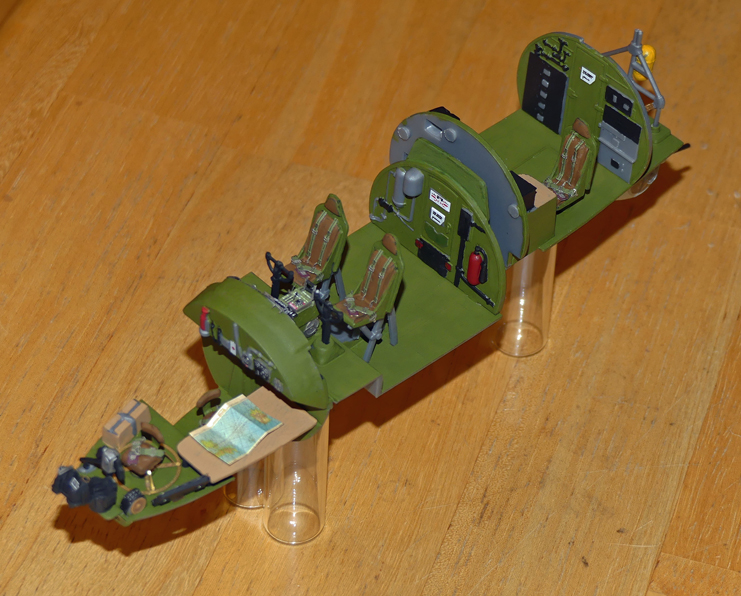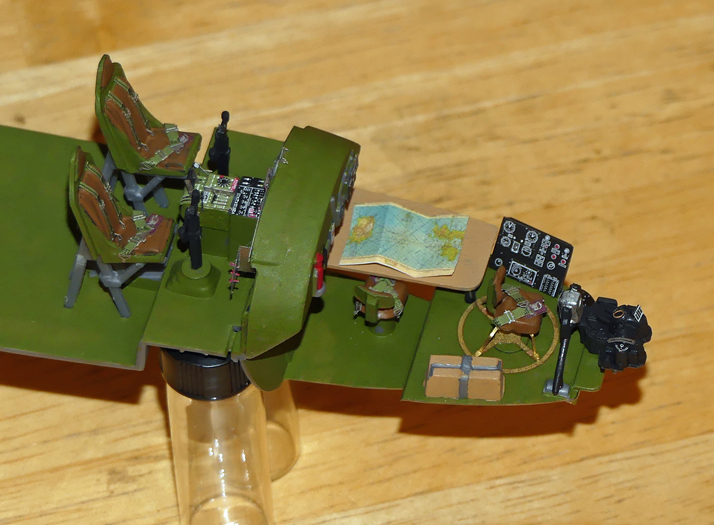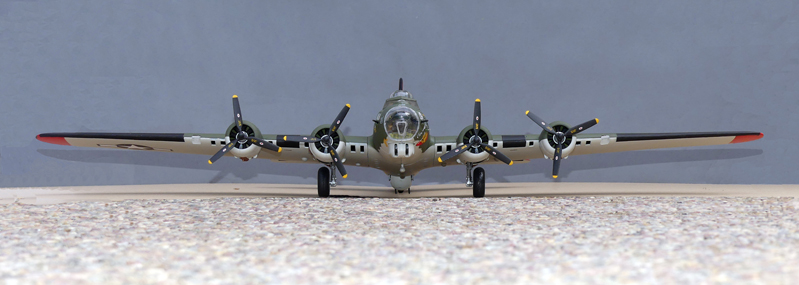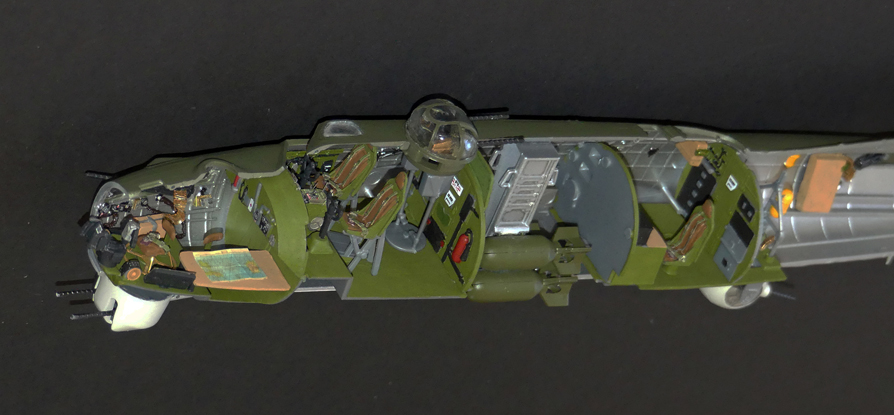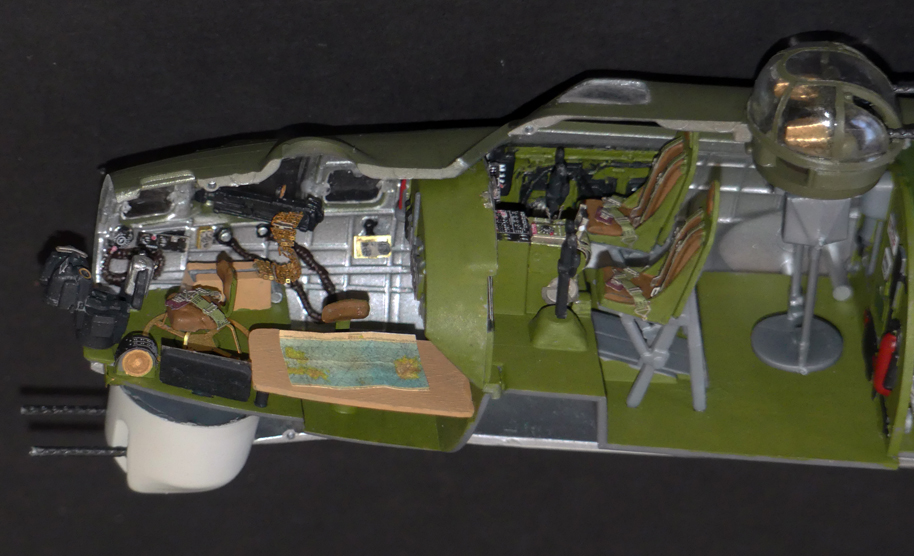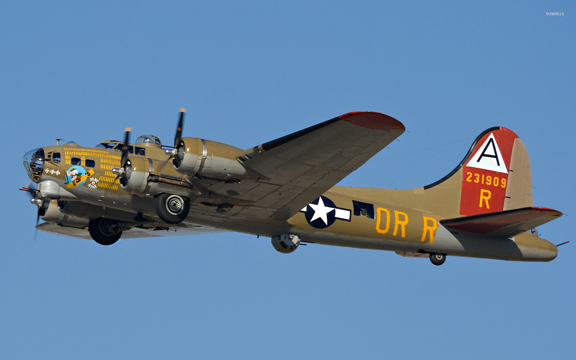

On July 28, 1935, a four-engine plane took off from Boeing Field in south Seattle on its first flight. Rolling out of the Boeing hangar, it was simply known as the Model 299. Seattle Times reporter Richard Smith dubbed the new plane, with its many machine-gun mounts, the “Flying Fortress,” a name that Boeing quickly adopted and trademarked. The U.S. Army Air Corps designated the plane as the B-17.
In response to the Army’s request for a large, multiengine bomber, the prototype, financed entirely by Boeing, went from design board to flight test in less than 12 months.
The B-17 was a low-wing monoplane that combined aerodynamic features of the XB-15 giant bomber, still in the design stage, and the Model 247 transport. The B-17 was the first Boeing military aircraft with a flight deck instead of an open cockpit and was armed with bombs and five .30-caliber machine guns mounted in clear “blisters.”
The first B-17s saw combat in 1941, when the British Royal Air Force took delivery of several B-17s for high-altitude missions. As World War II intensified, the bombers needed additional armament and armor.
The B-17E, the first mass-produced model Flying Fortress, carried nine machine guns and a 4,000-pound bomb load. It was several tons heavier than the prototypes and bristled with armament. It was the first Boeing airplane with the distinctive and enormous tail for improved control and stability during high-altitude bombing. Each version was more heavily armed.
The B-17G was the final mass produced version. Over 8,600 “G” models were built during the final 23 months of production. The major external change between the “F” and “G” models was the addition of a Bendix movable turret fitted on the underside of the nose. The twin .50 caliber guns mounted in this turret provided improved firepower to combat head-on attacks of skilled Luftwaffe pilots.
The initial B-17G’s to join operational units in Europe were finished in camouflage that was prevalent through most of World War II. As the crushing bombing offensive continued, allied air superiority negated the need for camouflage, and later versions appeared in a striking natural silver finish.
Throughout World War II, various versions of the B-17 served primarily with the Eighth, Twelfth and Fifteenth Air Force in the European Theater of Operations (ETO). In the Pacific, the planes earned a deadly reputation with the Japanese, who dubbed them “four-engine fighters.” The Fortresses were also legendary for their ability to stay in the air after taking brutal poundings.
Seventy-five years after the B-17’s first flight, an 88 year-old veteran sent The Boeing Company a letter. After explaining how he returned to England after a bombing raid over Germany with 179 flak holes and only two out of the four engines, he wrote: “I’m glad to be alive. Thank you for making such a good airplane.”
Gen. Carl Spaatz, the American air commander in Europe, said, “Without the B-17 we may have lost the war.”
Boeing Plant 2 located in King County, Washington built a total of 6,981 B-17s in various models, and another 5,745 were built under a nationwide collaborative effort by Douglas and Lockheed (Vega). Only a few B-17s survive today, featured at museums and air shows; most were scrapped at the end of the war. They were producing them so fast that when the war ended, many went right from the factories to being scrapped.
I flew on the B-17G “Nino-O-Nine” operated by the Collings Foundation pictured above in 2015. Four and a half years later on October 2, 2019, it crashed at Bradley International Airport in Windsor Locks, Connecticut. Shortly after takeoff, it lost an engine and tried to make an emergency landing. The aircraft came in low, touched down 1,000 feet (300 m) short of the runway, clipped the instrument landing system (ILS) antenna array, veered to the right off the runway across a grassy area and taxiway, then crashed into a de-icing facility and burst into flames. Seven of the thirteen people on board were killed and the other six, as well as one person on the ground, were injured.
Here's a short video of my flight on that plane. I stuck my head out of the opening above the radio operator's compartment shortly after takeoff to get some of the video.
Facts and General Characteristics of the B-17G Flying Fortress:
Manufacturer: Boeing
Type: Heavy Bomber
Crew: Ten: Pilot, co-pilot, bombardier, navigator, radio operator and five gunners (the bombardier, navigator and radio operator could also fire guns in their compartments).
Wingspan: 103 ft. 9 in. (31.6 m)
Length: 74 ft. 4 in. (22.66 m)
Height: 19 ft. 1 in. (5.82 m)
Gross Weight: 54,000 lbs. (24,494 kg)
Power Plant: 4 X 1,200-horsepower (890 kW0) Wright R-1820-97 "Cyclone" turbosupercharged radial engines
Max Speed: 287 mph (462 km/h)
Cruising Speed: 182 mph (293 km/h)
Ceiling: 35,600 ft. (10,900 m)
Range: 3,750 miles (6,035 km), less depending on bomb load.
Armament: 13 X .50 cal M2 Browning machine guns
Bomb Load: 4,500 lbs. (2,000 kg) to 17,600 lbs. (7,800 kg) depending on mission range.
Facts and General Characteristics of the Model:
The model is a representation of “Chow Hound”, the Boeing-built B-17G 42-31367 which was assigned to the 322nd Squadron of the 91st Bomb Group stationed at Bassingbourn, England. Its first mission was on January 29, 1944 with Lt. Jerry Newquist at the controls. Newquist named her “Chow Hound”. He had group artist Tony Starcer add a nose painting of Walt Disney’s famous cartoon dog, Pluto. By March 12th, 1944 “Chow Hound” had completed 15 missions, was credited with 19 aerial victories and the crew returned home. Newquist went on to become a United Airlines pilot.
The last pilot of the aircraft was Lt. Jack Thompson whose crew was flying its 13th mission over Caen on August 8th, 1944 when the aircraft was cut in half by flak. Thomson was the only crew member to survive becoming a prisoner of war.
Like all my other models, I don’t portray weathering or wear. I paint the planes as they looked coming out of the factories but I do include the nose art, crew names and bombing mission symbols which were added after the planes entered service.
Model Manufacturer: Revell, Inc. (Made in China)
Photo-etched brass sets: Eduard-Model Accessories, spol.s.r.o., Czech Republic
Scale: 1/48
Wingspan: 26”
Length: 19”
Height (tip of vertical stabilizer): 4.8”
Plastic Parts: 148
Photo-etched brass interior parts: 186 (I used about half)
Decals: 87
Hours to build and paint airplane, bomb cart and figures: 83


